MGT502 - Annotated Bibliography: Communication in Organizations
VerifiedAdded on 2023/03/21
|11
|2530
|98
Annotated Bibliography
AI Summary
This annotated bibliography examines the effects of poor communication on organizational outcomes, analyzing ten sources to identify key issues and potential solutions. The sources cover a range of topics including ineffective communication in businesses, the importance of communication skills for managers, the impact of cultural diversity on communication, workplace diversity and intercultural communication challenges, causes and effects of poor communication in the construction industry, the role of effective communication in strategic management, change management communication barriers, communication problems in management, the impact of organizational communication on employee performance and motivation, and the relationship between organizational communication and employee motivation. Each annotation summarizes the article's main points, assesses its authority, and explains its relevance to the broader topic of business communication and organizational effectiveness. The bibliography highlights the need for organizations to adopt effective communication strategies, address cultural differences, and implement systems that promote positive organizational outcomes.
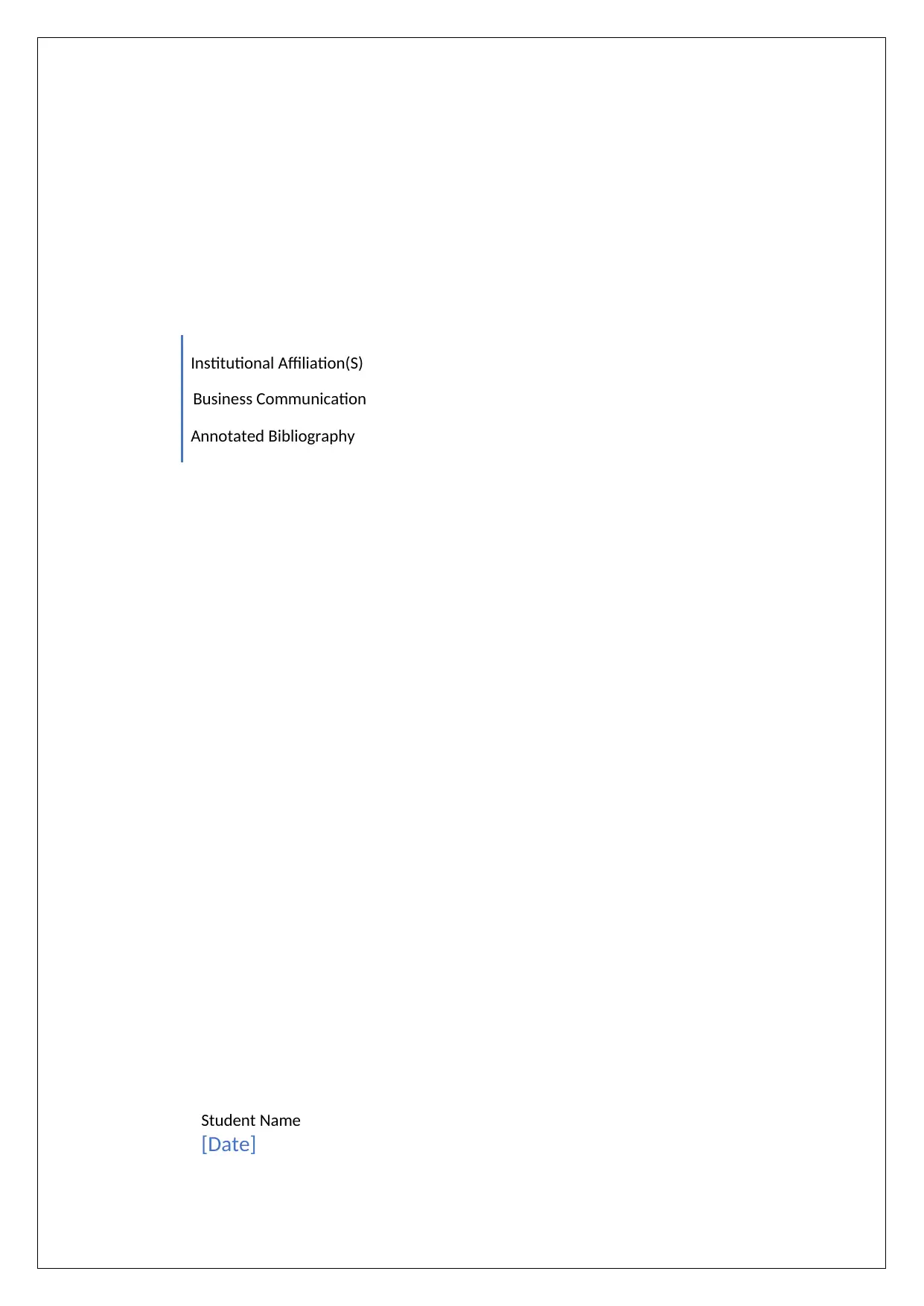
Institutional Affiliation(S)
Business Communication
Annotated Bibliography
Student Name
[Date]
Business Communication
Annotated Bibliography
Student Name
[Date]
Paraphrase This Document
Need a fresh take? Get an instant paraphrase of this document with our AI Paraphraser
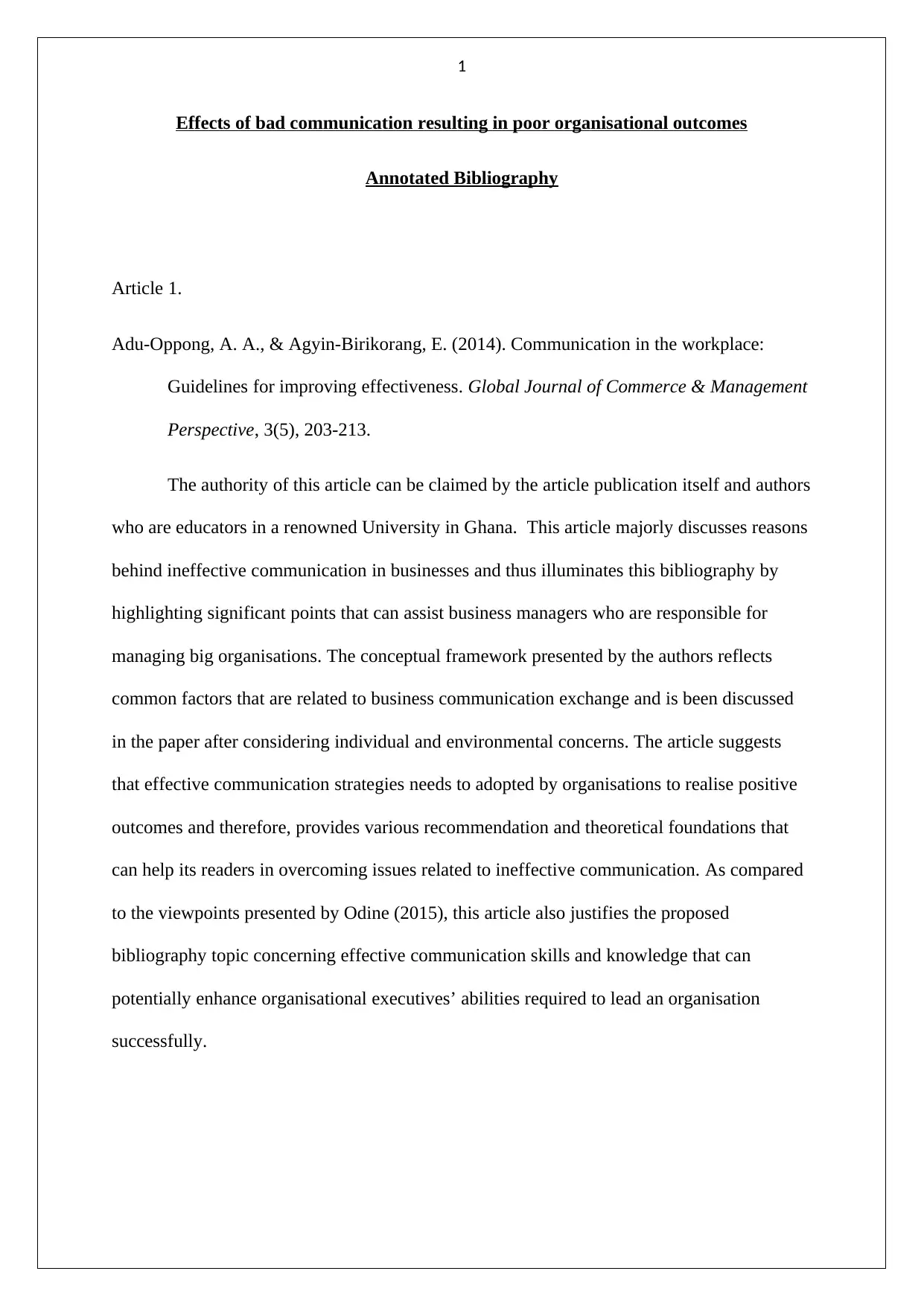
1
Effects of bad communication resulting in poor organisational outcomes
Annotated Bibliography
Article 1.
Adu-Oppong, A. A., & Agyin-Birikorang, E. (2014). Communication in the workplace:
Guidelines for improving effectiveness. Global Journal of Commerce & Management
Perspective, 3(5), 203-213.
The authority of this article can be claimed by the article publication itself and authors
who are educators in a renowned University in Ghana. This article majorly discusses reasons
behind ineffective communication in businesses and thus illuminates this bibliography by
highlighting significant points that can assist business managers who are responsible for
managing big organisations. The conceptual framework presented by the authors reflects
common factors that are related to business communication exchange and is been discussed
in the paper after considering individual and environmental concerns. The article suggests
that effective communication strategies needs to adopted by organisations to realise positive
outcomes and therefore, provides various recommendation and theoretical foundations that
can help its readers in overcoming issues related to ineffective communication. As compared
to the viewpoints presented by Odine (2015), this article also justifies the proposed
bibliography topic concerning effective communication skills and knowledge that can
potentially enhance organisational executives’ abilities required to lead an organisation
successfully.
Effects of bad communication resulting in poor organisational outcomes
Annotated Bibliography
Article 1.
Adu-Oppong, A. A., & Agyin-Birikorang, E. (2014). Communication in the workplace:
Guidelines for improving effectiveness. Global Journal of Commerce & Management
Perspective, 3(5), 203-213.
The authority of this article can be claimed by the article publication itself and authors
who are educators in a renowned University in Ghana. This article majorly discusses reasons
behind ineffective communication in businesses and thus illuminates this bibliography by
highlighting significant points that can assist business managers who are responsible for
managing big organisations. The conceptual framework presented by the authors reflects
common factors that are related to business communication exchange and is been discussed
in the paper after considering individual and environmental concerns. The article suggests
that effective communication strategies needs to adopted by organisations to realise positive
outcomes and therefore, provides various recommendation and theoretical foundations that
can help its readers in overcoming issues related to ineffective communication. As compared
to the viewpoints presented by Odine (2015), this article also justifies the proposed
bibliography topic concerning effective communication skills and knowledge that can
potentially enhance organisational executives’ abilities required to lead an organisation
successfully.
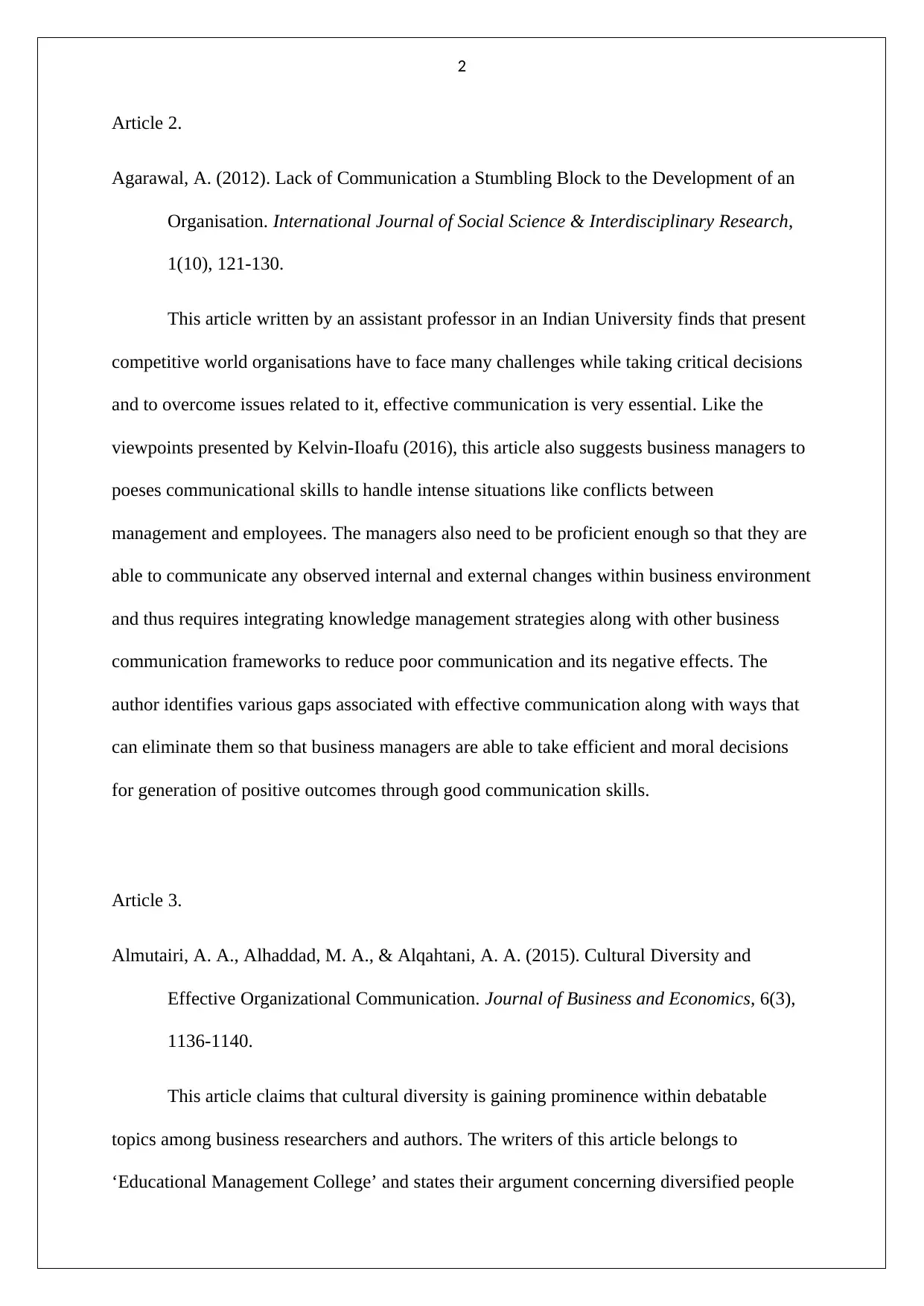
2
Article 2.
Agarawal, A. (2012). Lack of Communication a Stumbling Block to the Development of an
Organisation. International Journal of Social Science & Interdisciplinary Research,
1(10), 121-130.
This article written by an assistant professor in an Indian University finds that present
competitive world organisations have to face many challenges while taking critical decisions
and to overcome issues related to it, effective communication is very essential. Like the
viewpoints presented by Kelvin-Iloafu (2016), this article also suggests business managers to
poeses communicational skills to handle intense situations like conflicts between
management and employees. The managers also need to be proficient enough so that they are
able to communicate any observed internal and external changes within business environment
and thus requires integrating knowledge management strategies along with other business
communication frameworks to reduce poor communication and its negative effects. The
author identifies various gaps associated with effective communication along with ways that
can eliminate them so that business managers are able to take efficient and moral decisions
for generation of positive outcomes through good communication skills.
Article 3.
Almutairi, A. A., Alhaddad, M. A., & Alqahtani, A. A. (2015). Cultural Diversity and
Effective Organizational Communication. Journal of Business and Economics, 6(3),
1136-1140.
This article claims that cultural diversity is gaining prominence within debatable
topics among business researchers and authors. The writers of this article belongs to
‘Educational Management College’ and states their argument concerning diversified people
Article 2.
Agarawal, A. (2012). Lack of Communication a Stumbling Block to the Development of an
Organisation. International Journal of Social Science & Interdisciplinary Research,
1(10), 121-130.
This article written by an assistant professor in an Indian University finds that present
competitive world organisations have to face many challenges while taking critical decisions
and to overcome issues related to it, effective communication is very essential. Like the
viewpoints presented by Kelvin-Iloafu (2016), this article also suggests business managers to
poeses communicational skills to handle intense situations like conflicts between
management and employees. The managers also need to be proficient enough so that they are
able to communicate any observed internal and external changes within business environment
and thus requires integrating knowledge management strategies along with other business
communication frameworks to reduce poor communication and its negative effects. The
author identifies various gaps associated with effective communication along with ways that
can eliminate them so that business managers are able to take efficient and moral decisions
for generation of positive outcomes through good communication skills.
Article 3.
Almutairi, A. A., Alhaddad, M. A., & Alqahtani, A. A. (2015). Cultural Diversity and
Effective Organizational Communication. Journal of Business and Economics, 6(3),
1136-1140.
This article claims that cultural diversity is gaining prominence within debatable
topics among business researchers and authors. The writers of this article belongs to
‘Educational Management College’ and states their argument concerning diversified people
⊘ This is a preview!⊘
Do you want full access?
Subscribe today to unlock all pages.

Trusted by 1+ million students worldwide
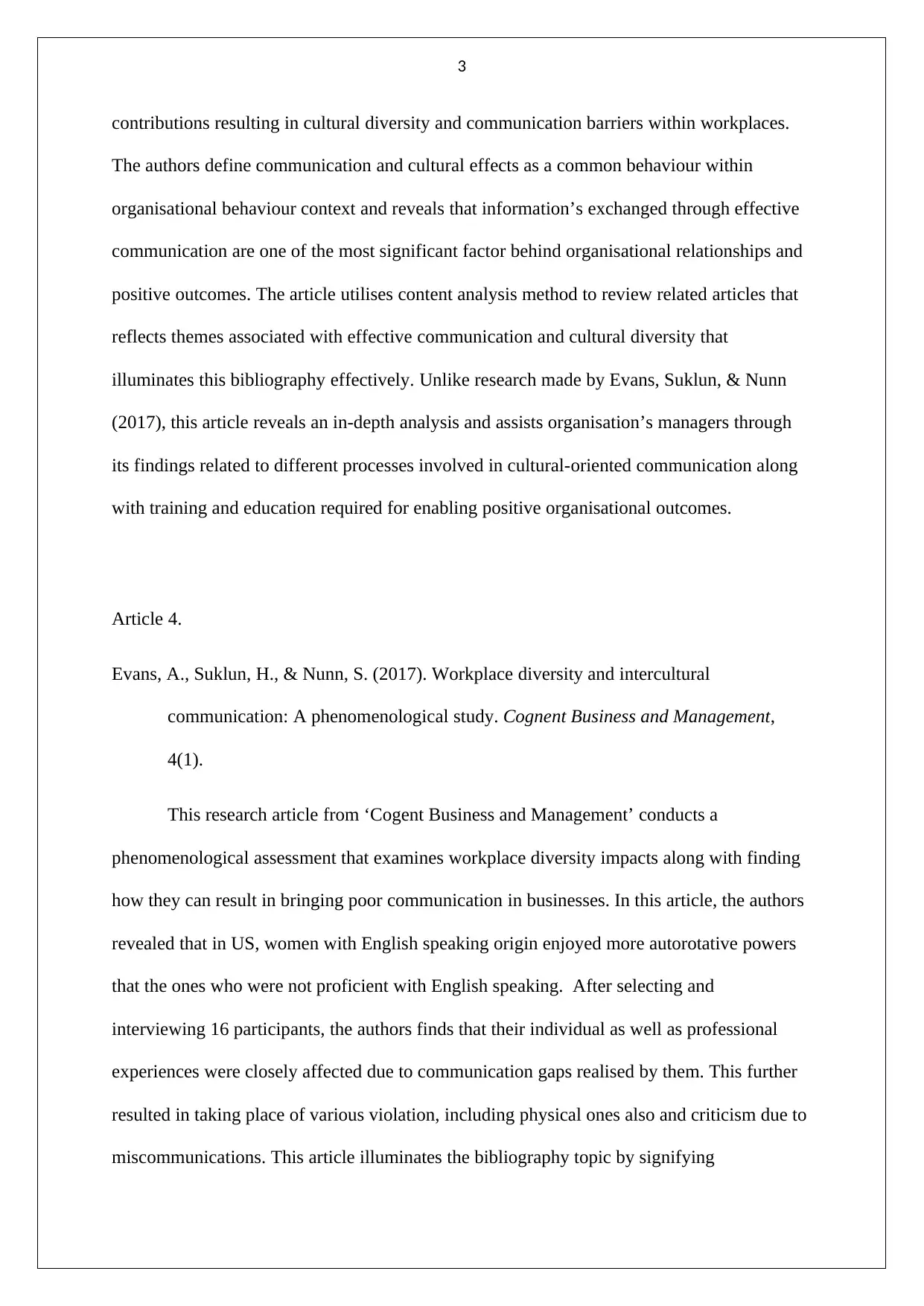
3
contributions resulting in cultural diversity and communication barriers within workplaces.
The authors define communication and cultural effects as a common behaviour within
organisational behaviour context and reveals that information’s exchanged through effective
communication are one of the most significant factor behind organisational relationships and
positive outcomes. The article utilises content analysis method to review related articles that
reflects themes associated with effective communication and cultural diversity that
illuminates this bibliography effectively. Unlike research made by Evans, Suklun, & Nunn
(2017), this article reveals an in-depth analysis and assists organisation’s managers through
its findings related to different processes involved in cultural-oriented communication along
with training and education required for enabling positive organisational outcomes.
Article 4.
Evans, A., Suklun, H., & Nunn, S. (2017). Workplace diversity and intercultural
communication: A phenomenological study. Cognent Business and Management,
4(1).
This research article from ‘Cogent Business and Management’ conducts a
phenomenological assessment that examines workplace diversity impacts along with finding
how they can result in bringing poor communication in businesses. In this article, the authors
revealed that in US, women with English speaking origin enjoyed more autorotative powers
that the ones who were not proficient with English speaking. After selecting and
interviewing 16 participants, the authors finds that their individual as well as professional
experiences were closely affected due to communication gaps realised by them. This further
resulted in taking place of various violation, including physical ones also and criticism due to
miscommunications. This article illuminates the bibliography topic by signifying
contributions resulting in cultural diversity and communication barriers within workplaces.
The authors define communication and cultural effects as a common behaviour within
organisational behaviour context and reveals that information’s exchanged through effective
communication are one of the most significant factor behind organisational relationships and
positive outcomes. The article utilises content analysis method to review related articles that
reflects themes associated with effective communication and cultural diversity that
illuminates this bibliography effectively. Unlike research made by Evans, Suklun, & Nunn
(2017), this article reveals an in-depth analysis and assists organisation’s managers through
its findings related to different processes involved in cultural-oriented communication along
with training and education required for enabling positive organisational outcomes.
Article 4.
Evans, A., Suklun, H., & Nunn, S. (2017). Workplace diversity and intercultural
communication: A phenomenological study. Cognent Business and Management,
4(1).
This research article from ‘Cogent Business and Management’ conducts a
phenomenological assessment that examines workplace diversity impacts along with finding
how they can result in bringing poor communication in businesses. In this article, the authors
revealed that in US, women with English speaking origin enjoyed more autorotative powers
that the ones who were not proficient with English speaking. After selecting and
interviewing 16 participants, the authors finds that their individual as well as professional
experiences were closely affected due to communication gaps realised by them. This further
resulted in taking place of various violation, including physical ones also and criticism due to
miscommunications. This article illuminates the bibliography topic by signifying
Paraphrase This Document
Need a fresh take? Get an instant paraphrase of this document with our AI Paraphraser
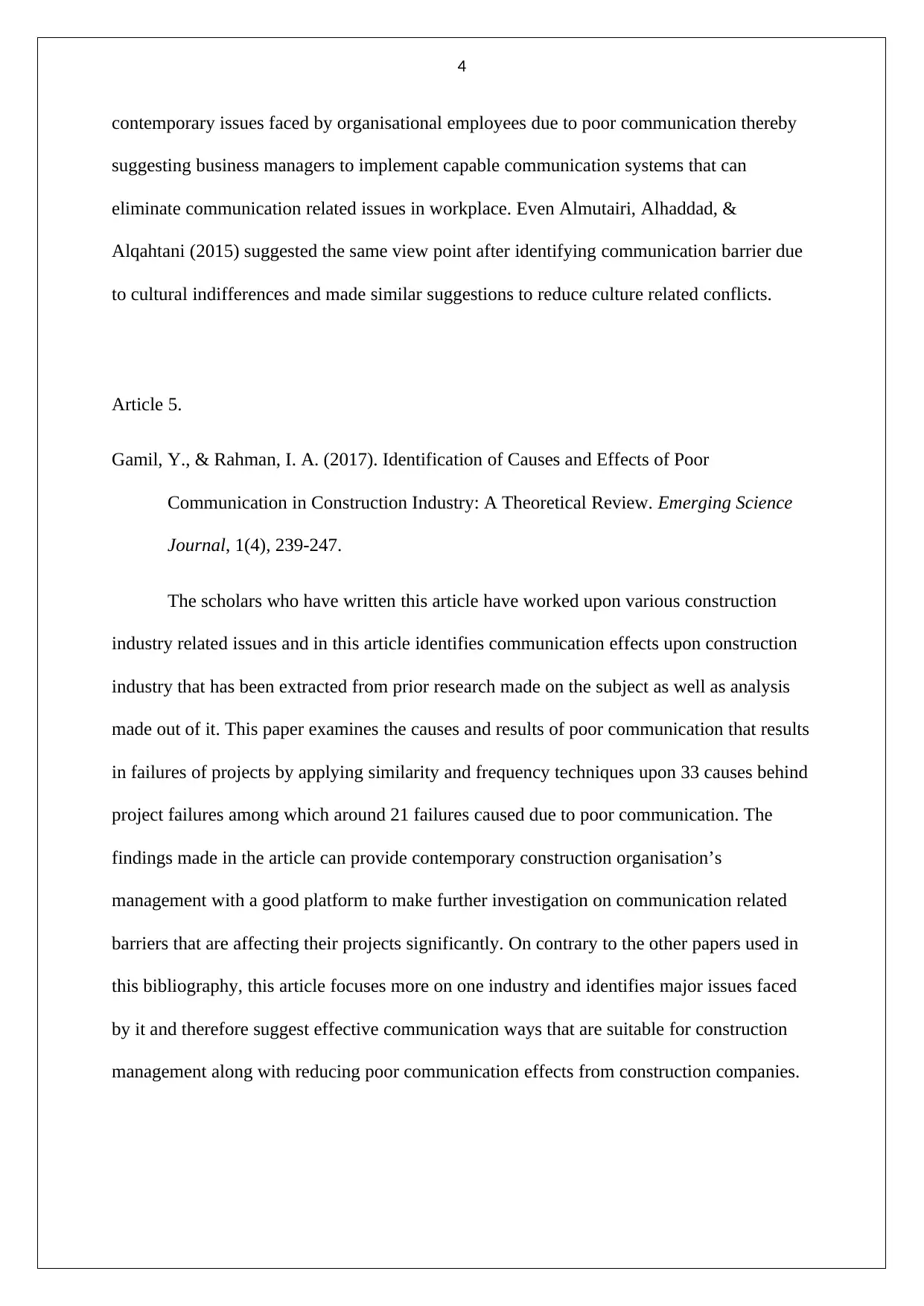
4
contemporary issues faced by organisational employees due to poor communication thereby
suggesting business managers to implement capable communication systems that can
eliminate communication related issues in workplace. Even Almutairi, Alhaddad, &
Alqahtani (2015) suggested the same view point after identifying communication barrier due
to cultural indifferences and made similar suggestions to reduce culture related conflicts.
Article 5.
Gamil, Y., & Rahman, I. A. (2017). Identification of Causes and Effects of Poor
Communication in Construction Industry: A Theoretical Review. Emerging Science
Journal, 1(4), 239-247.
The scholars who have written this article have worked upon various construction
industry related issues and in this article identifies communication effects upon construction
industry that has been extracted from prior research made on the subject as well as analysis
made out of it. This paper examines the causes and results of poor communication that results
in failures of projects by applying similarity and frequency techniques upon 33 causes behind
project failures among which around 21 failures caused due to poor communication. The
findings made in the article can provide contemporary construction organisation’s
management with a good platform to make further investigation on communication related
barriers that are affecting their projects significantly. On contrary to the other papers used in
this bibliography, this article focuses more on one industry and identifies major issues faced
by it and therefore suggest effective communication ways that are suitable for construction
management along with reducing poor communication effects from construction companies.
contemporary issues faced by organisational employees due to poor communication thereby
suggesting business managers to implement capable communication systems that can
eliminate communication related issues in workplace. Even Almutairi, Alhaddad, &
Alqahtani (2015) suggested the same view point after identifying communication barrier due
to cultural indifferences and made similar suggestions to reduce culture related conflicts.
Article 5.
Gamil, Y., & Rahman, I. A. (2017). Identification of Causes and Effects of Poor
Communication in Construction Industry: A Theoretical Review. Emerging Science
Journal, 1(4), 239-247.
The scholars who have written this article have worked upon various construction
industry related issues and in this article identifies communication effects upon construction
industry that has been extracted from prior research made on the subject as well as analysis
made out of it. This paper examines the causes and results of poor communication that results
in failures of projects by applying similarity and frequency techniques upon 33 causes behind
project failures among which around 21 failures caused due to poor communication. The
findings made in the article can provide contemporary construction organisation’s
management with a good platform to make further investigation on communication related
barriers that are affecting their projects significantly. On contrary to the other papers used in
this bibliography, this article focuses more on one industry and identifies major issues faced
by it and therefore suggest effective communication ways that are suitable for construction
management along with reducing poor communication effects from construction companies.
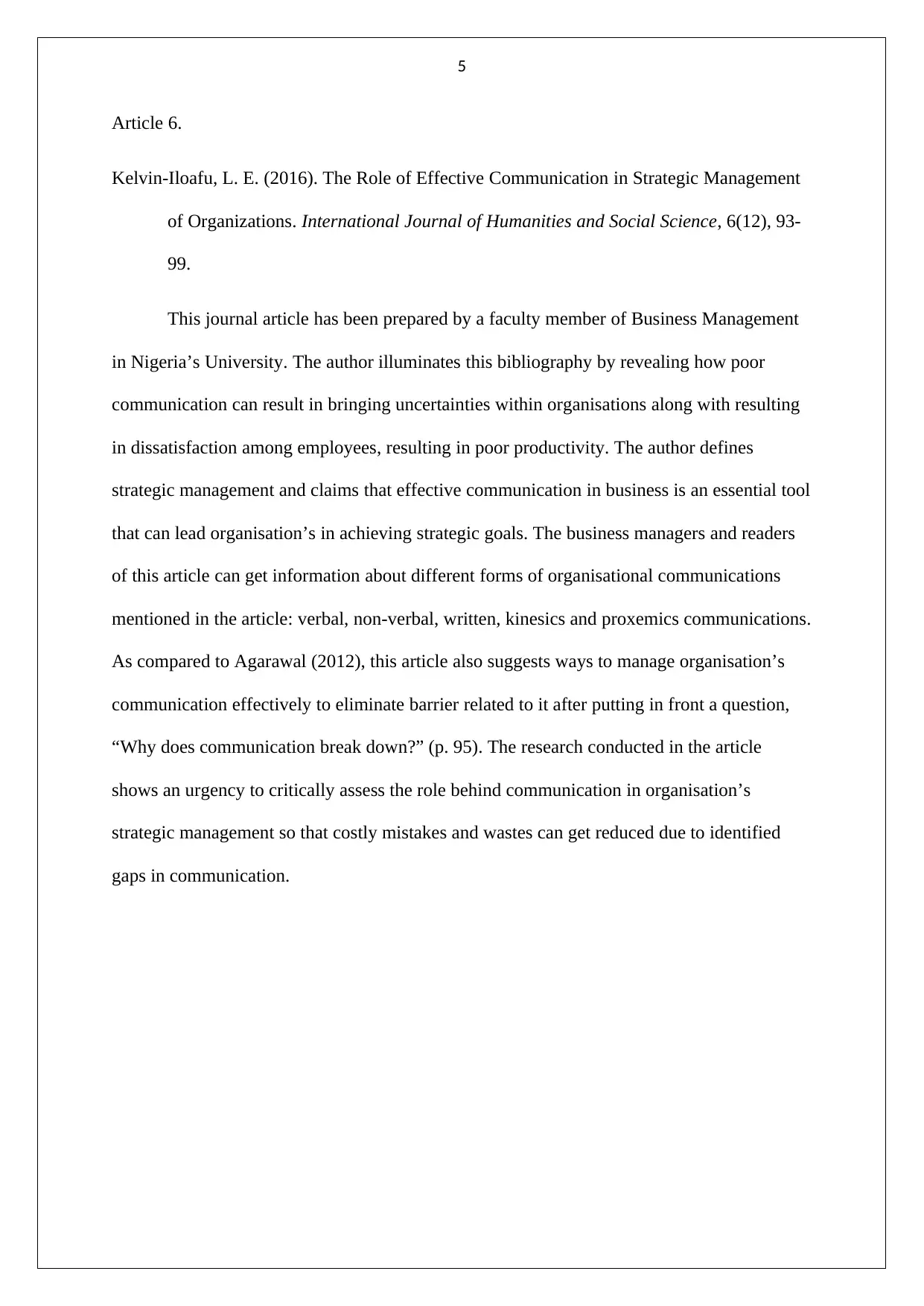
5
Article 6.
Kelvin-Iloafu, L. E. (2016). The Role of Effective Communication in Strategic Management
of Organizations. International Journal of Humanities and Social Science, 6(12), 93-
99.
This journal article has been prepared by a faculty member of Business Management
in Nigeria’s University. The author illuminates this bibliography by revealing how poor
communication can result in bringing uncertainties within organisations along with resulting
in dissatisfaction among employees, resulting in poor productivity. The author defines
strategic management and claims that effective communication in business is an essential tool
that can lead organisation’s in achieving strategic goals. The business managers and readers
of this article can get information about different forms of organisational communications
mentioned in the article: verbal, non-verbal, written, kinesics and proxemics communications.
As compared to Agarawal (2012), this article also suggests ways to manage organisation’s
communication effectively to eliminate barrier related to it after putting in front a question,
“Why does communication break down?” (p. 95). The research conducted in the article
shows an urgency to critically assess the role behind communication in organisation’s
strategic management so that costly mistakes and wastes can get reduced due to identified
gaps in communication.
Article 6.
Kelvin-Iloafu, L. E. (2016). The Role of Effective Communication in Strategic Management
of Organizations. International Journal of Humanities and Social Science, 6(12), 93-
99.
This journal article has been prepared by a faculty member of Business Management
in Nigeria’s University. The author illuminates this bibliography by revealing how poor
communication can result in bringing uncertainties within organisations along with resulting
in dissatisfaction among employees, resulting in poor productivity. The author defines
strategic management and claims that effective communication in business is an essential tool
that can lead organisation’s in achieving strategic goals. The business managers and readers
of this article can get information about different forms of organisational communications
mentioned in the article: verbal, non-verbal, written, kinesics and proxemics communications.
As compared to Agarawal (2012), this article also suggests ways to manage organisation’s
communication effectively to eliminate barrier related to it after putting in front a question,
“Why does communication break down?” (p. 95). The research conducted in the article
shows an urgency to critically assess the role behind communication in organisation’s
strategic management so that costly mistakes and wastes can get reduced due to identified
gaps in communication.
⊘ This is a preview!⊘
Do you want full access?
Subscribe today to unlock all pages.

Trusted by 1+ million students worldwide
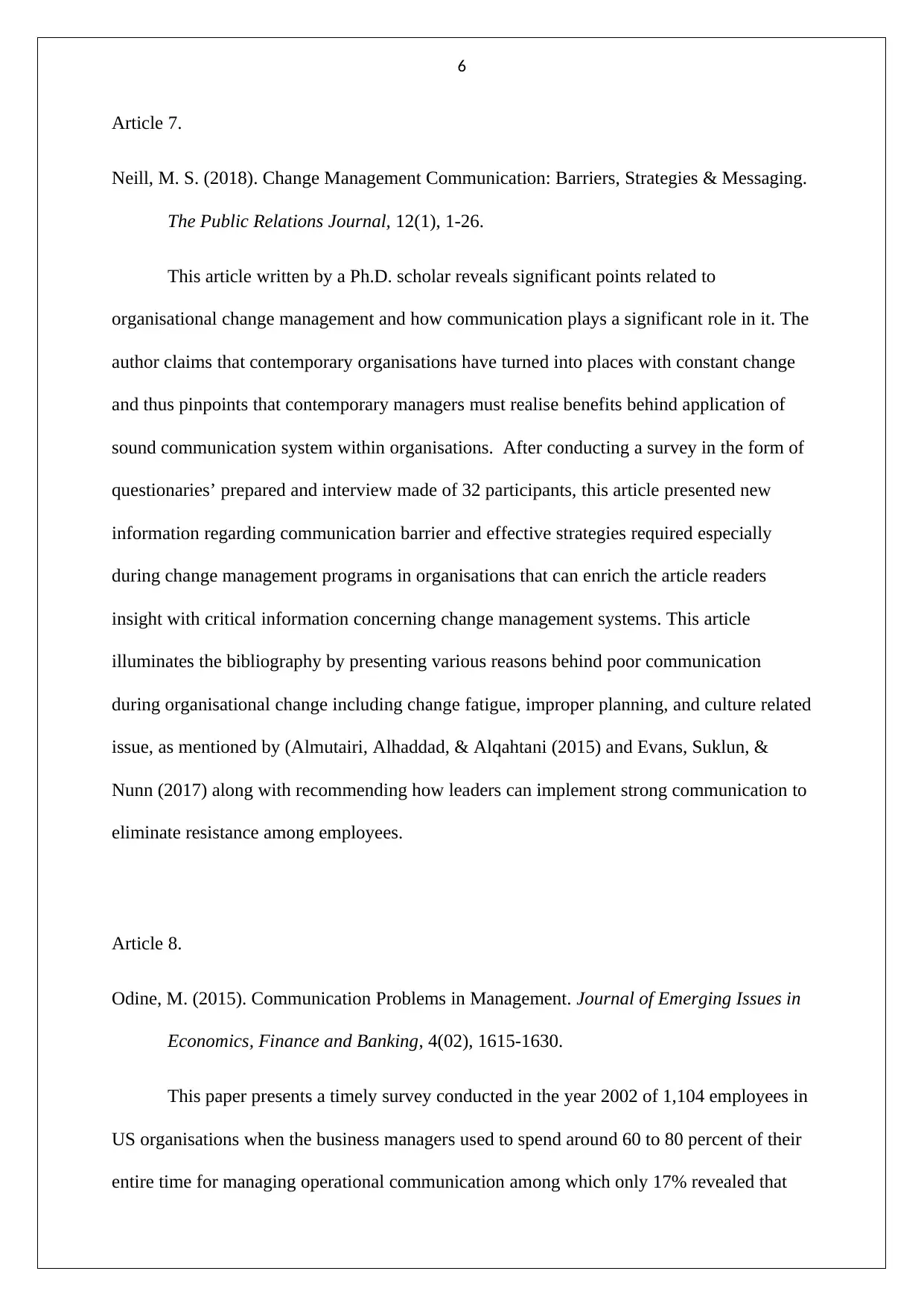
6
Article 7.
Neill, M. S. (2018). Change Management Communication: Barriers, Strategies & Messaging.
The Public Relations Journal, 12(1), 1-26.
This article written by a Ph.D. scholar reveals significant points related to
organisational change management and how communication plays a significant role in it. The
author claims that contemporary organisations have turned into places with constant change
and thus pinpoints that contemporary managers must realise benefits behind application of
sound communication system within organisations. After conducting a survey in the form of
questionaries’ prepared and interview made of 32 participants, this article presented new
information regarding communication barrier and effective strategies required especially
during change management programs in organisations that can enrich the article readers
insight with critical information concerning change management systems. This article
illuminates the bibliography by presenting various reasons behind poor communication
during organisational change including change fatigue, improper planning, and culture related
issue, as mentioned by (Almutairi, Alhaddad, & Alqahtani (2015) and Evans, Suklun, &
Nunn (2017) along with recommending how leaders can implement strong communication to
eliminate resistance among employees.
Article 8.
Odine, M. (2015). Communication Problems in Management. Journal of Emerging Issues in
Economics, Finance and Banking, 4(02), 1615-1630.
This paper presents a timely survey conducted in the year 2002 of 1,104 employees in
US organisations when the business managers used to spend around 60 to 80 percent of their
entire time for managing operational communication among which only 17% revealed that
Article 7.
Neill, M. S. (2018). Change Management Communication: Barriers, Strategies & Messaging.
The Public Relations Journal, 12(1), 1-26.
This article written by a Ph.D. scholar reveals significant points related to
organisational change management and how communication plays a significant role in it. The
author claims that contemporary organisations have turned into places with constant change
and thus pinpoints that contemporary managers must realise benefits behind application of
sound communication system within organisations. After conducting a survey in the form of
questionaries’ prepared and interview made of 32 participants, this article presented new
information regarding communication barrier and effective strategies required especially
during change management programs in organisations that can enrich the article readers
insight with critical information concerning change management systems. This article
illuminates the bibliography by presenting various reasons behind poor communication
during organisational change including change fatigue, improper planning, and culture related
issue, as mentioned by (Almutairi, Alhaddad, & Alqahtani (2015) and Evans, Suklun, &
Nunn (2017) along with recommending how leaders can implement strong communication to
eliminate resistance among employees.
Article 8.
Odine, M. (2015). Communication Problems in Management. Journal of Emerging Issues in
Economics, Finance and Banking, 4(02), 1615-1630.
This paper presents a timely survey conducted in the year 2002 of 1,104 employees in
US organisations when the business managers used to spend around 60 to 80 percent of their
entire time for managing operational communication among which only 17% revealed that
Paraphrase This Document
Need a fresh take? Get an instant paraphrase of this document with our AI Paraphraser

7
they could communicate properly. The author of this article is an associate dean in a well-
renowned university in the US and makes a suggestion to build a positive constructive
mechanism to extricate reasons behind improper communication within contemporary
workplaces. The quantitative and qualitative research conducted by the author illuminates this
bibliography by presenting in front of its readers and contemporary business leaders about
range of behavioural pattern and their perception driving issues in business communication.
Similar to the findings revealed by Adu-Oppong & Agyin-Birikorang (2014), this paper also
reflects upon various communication issues that act as a barrier between organisational
productivity and development.
Article 9.
Rukmana, H. D., Sopiah, M. P., & Elfia , N. S. (2018). The Impact of Organization
Communication on Employee Performance Through Employee’s Work Motivation at
Pt. Putri Panda Unit Ii Tulungagung, East Jawa, Indonesia. The First International
Research Conference on Economics and Business, 211-227.
This article has been selected and peer-reviewed by an authoritative source, 1st
IRCEB Conference Committee. The basic purpose behind the article authors is to determine
and describe the organisational communication and its relationship between employee
performance and motivation in PT Putri Panda Unit II Tulungagung. After conducting a path
analysis, the authors find that organisational communication have direct and indirect impacts
upon employee’s performance as it effects motivational characteristics in them. Like Semren
(2017), this article authors also prepared a questionarie that assisted them in covering chief
instruments, interview and keen observation of the employees working in their selected
organisation. The authors conclude on the notion that organisational communication can be
they could communicate properly. The author of this article is an associate dean in a well-
renowned university in the US and makes a suggestion to build a positive constructive
mechanism to extricate reasons behind improper communication within contemporary
workplaces. The quantitative and qualitative research conducted by the author illuminates this
bibliography by presenting in front of its readers and contemporary business leaders about
range of behavioural pattern and their perception driving issues in business communication.
Similar to the findings revealed by Adu-Oppong & Agyin-Birikorang (2014), this paper also
reflects upon various communication issues that act as a barrier between organisational
productivity and development.
Article 9.
Rukmana, H. D., Sopiah, M. P., & Elfia , N. S. (2018). The Impact of Organization
Communication on Employee Performance Through Employee’s Work Motivation at
Pt. Putri Panda Unit Ii Tulungagung, East Jawa, Indonesia. The First International
Research Conference on Economics and Business, 211-227.
This article has been selected and peer-reviewed by an authoritative source, 1st
IRCEB Conference Committee. The basic purpose behind the article authors is to determine
and describe the organisational communication and its relationship between employee
performance and motivation in PT Putri Panda Unit II Tulungagung. After conducting a path
analysis, the authors find that organisational communication have direct and indirect impacts
upon employee’s performance as it effects motivational characteristics in them. Like Semren
(2017), this article authors also prepared a questionarie that assisted them in covering chief
instruments, interview and keen observation of the employees working in their selected
organisation. The authors conclude on the notion that organisational communication can be
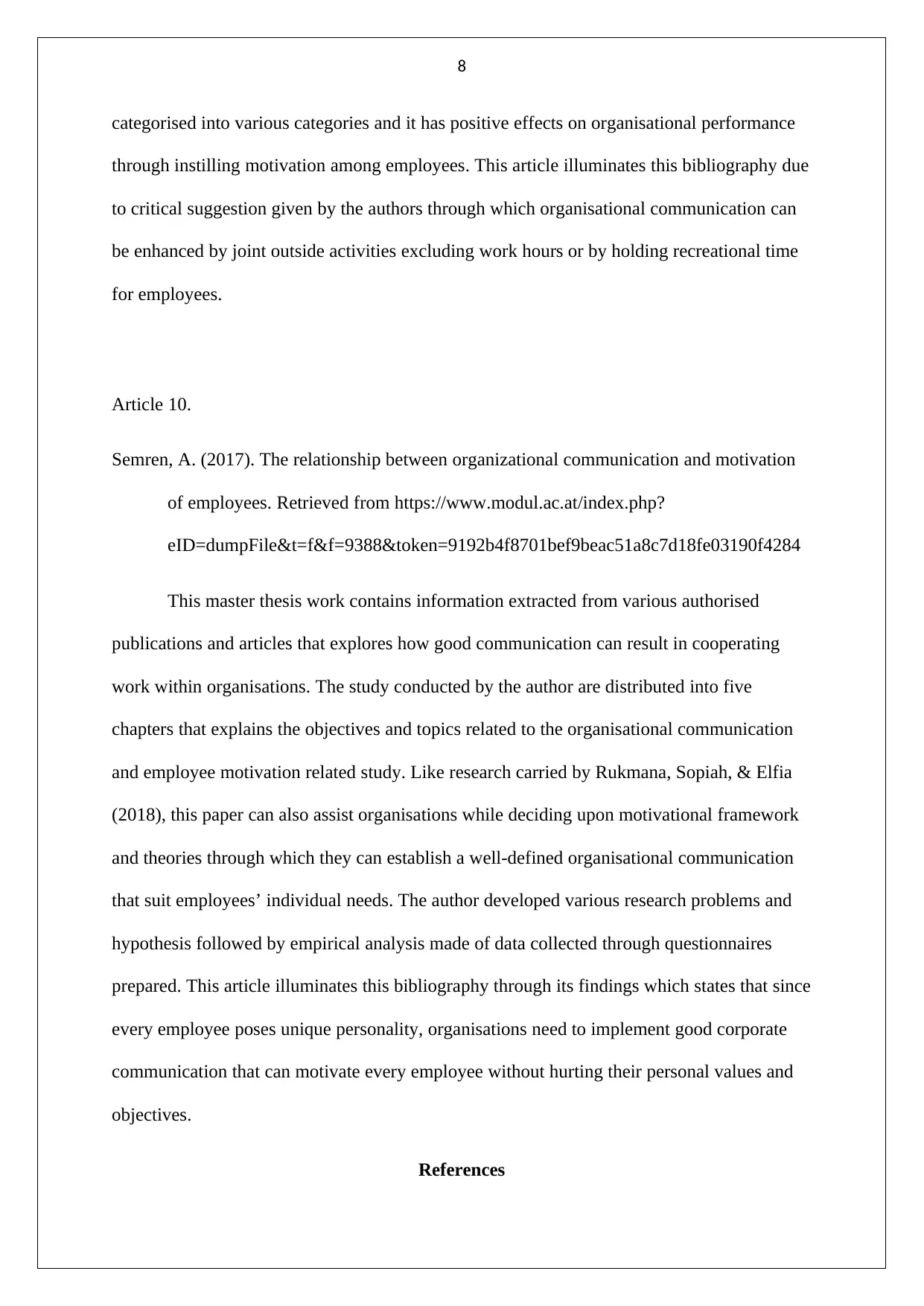
8
categorised into various categories and it has positive effects on organisational performance
through instilling motivation among employees. This article illuminates this bibliography due
to critical suggestion given by the authors through which organisational communication can
be enhanced by joint outside activities excluding work hours or by holding recreational time
for employees.
Article 10.
Semren, A. (2017). The relationship between organizational communication and motivation
of employees. Retrieved from https://www.modul.ac.at/index.php?
eID=dumpFile&t=f&f=9388&token=9192b4f8701bef9beac51a8c7d18fe03190f4284
This master thesis work contains information extracted from various authorised
publications and articles that explores how good communication can result in cooperating
work within organisations. The study conducted by the author are distributed into five
chapters that explains the objectives and topics related to the organisational communication
and employee motivation related study. Like research carried by Rukmana, Sopiah, & Elfia
(2018), this paper can also assist organisations while deciding upon motivational framework
and theories through which they can establish a well-defined organisational communication
that suit employees’ individual needs. The author developed various research problems and
hypothesis followed by empirical analysis made of data collected through questionnaires
prepared. This article illuminates this bibliography through its findings which states that since
every employee poses unique personality, organisations need to implement good corporate
communication that can motivate every employee without hurting their personal values and
objectives.
References
categorised into various categories and it has positive effects on organisational performance
through instilling motivation among employees. This article illuminates this bibliography due
to critical suggestion given by the authors through which organisational communication can
be enhanced by joint outside activities excluding work hours or by holding recreational time
for employees.
Article 10.
Semren, A. (2017). The relationship between organizational communication and motivation
of employees. Retrieved from https://www.modul.ac.at/index.php?
eID=dumpFile&t=f&f=9388&token=9192b4f8701bef9beac51a8c7d18fe03190f4284
This master thesis work contains information extracted from various authorised
publications and articles that explores how good communication can result in cooperating
work within organisations. The study conducted by the author are distributed into five
chapters that explains the objectives and topics related to the organisational communication
and employee motivation related study. Like research carried by Rukmana, Sopiah, & Elfia
(2018), this paper can also assist organisations while deciding upon motivational framework
and theories through which they can establish a well-defined organisational communication
that suit employees’ individual needs. The author developed various research problems and
hypothesis followed by empirical analysis made of data collected through questionnaires
prepared. This article illuminates this bibliography through its findings which states that since
every employee poses unique personality, organisations need to implement good corporate
communication that can motivate every employee without hurting their personal values and
objectives.
References
⊘ This is a preview!⊘
Do you want full access?
Subscribe today to unlock all pages.

Trusted by 1+ million students worldwide

9
Adu-Oppong, A. A., & Agyin-Birikorang, E. (2014). Communication in the workplace:
Guidelines for improving effectiveness. Global Journal of Commerce & Management
Perspective, 3(5), 203-213. Retrieved from
https://www.longdom.org/articles/communication-in-the-workplace-guidelines-for-
improving-effectiveness.pdf
Agarawal, A. (2012). Lack of Communication a Stumbling Block to the Development of an
Organisation. International Journal of Social Science & Interdisciplinary Research,
1(10), 121-130.
Almutairi, A. A., Alhaddad, M. A., & Alqahtani, A. A. (2015). Cultural Diversity and
Effective Organizational Communication. Journal of Business and Economics, 6(3),
1136-1140. Retrieved from http://www.academicstar.us/UploadFile/Picture/2015-
9/20159291037130.pdf
Evans, A., Suklun, H., & Nunn, S. (2017). Workplace diversity and intercultural
communication: A phenomenological study. Cognent Business and Management,
4(1). Retrieved from
https://www.tandfonline.com/doi/abs/10.1080/23311975.2017.1408943
Gamil , Y., & Rahman, I. A. (2017). Identification of Causes and Effects of Poor
Communication in Construction Industry: A Theoretical Review. Emerging Science
Journal, 1(4), 239-247.
Kelvin-Iloafu, L. E. (2016). The Role of Effective Communication in Strategic Management
of Organizations. International Journal of Humanities and Social Science, 6(12), 93-
99.
Adu-Oppong, A. A., & Agyin-Birikorang, E. (2014). Communication in the workplace:
Guidelines for improving effectiveness. Global Journal of Commerce & Management
Perspective, 3(5), 203-213. Retrieved from
https://www.longdom.org/articles/communication-in-the-workplace-guidelines-for-
improving-effectiveness.pdf
Agarawal, A. (2012). Lack of Communication a Stumbling Block to the Development of an
Organisation. International Journal of Social Science & Interdisciplinary Research,
1(10), 121-130.
Almutairi, A. A., Alhaddad, M. A., & Alqahtani, A. A. (2015). Cultural Diversity and
Effective Organizational Communication. Journal of Business and Economics, 6(3),
1136-1140. Retrieved from http://www.academicstar.us/UploadFile/Picture/2015-
9/20159291037130.pdf
Evans, A., Suklun, H., & Nunn, S. (2017). Workplace diversity and intercultural
communication: A phenomenological study. Cognent Business and Management,
4(1). Retrieved from
https://www.tandfonline.com/doi/abs/10.1080/23311975.2017.1408943
Gamil , Y., & Rahman, I. A. (2017). Identification of Causes and Effects of Poor
Communication in Construction Industry: A Theoretical Review. Emerging Science
Journal, 1(4), 239-247.
Kelvin-Iloafu, L. E. (2016). The Role of Effective Communication in Strategic Management
of Organizations. International Journal of Humanities and Social Science, 6(12), 93-
99.
Paraphrase This Document
Need a fresh take? Get an instant paraphrase of this document with our AI Paraphraser
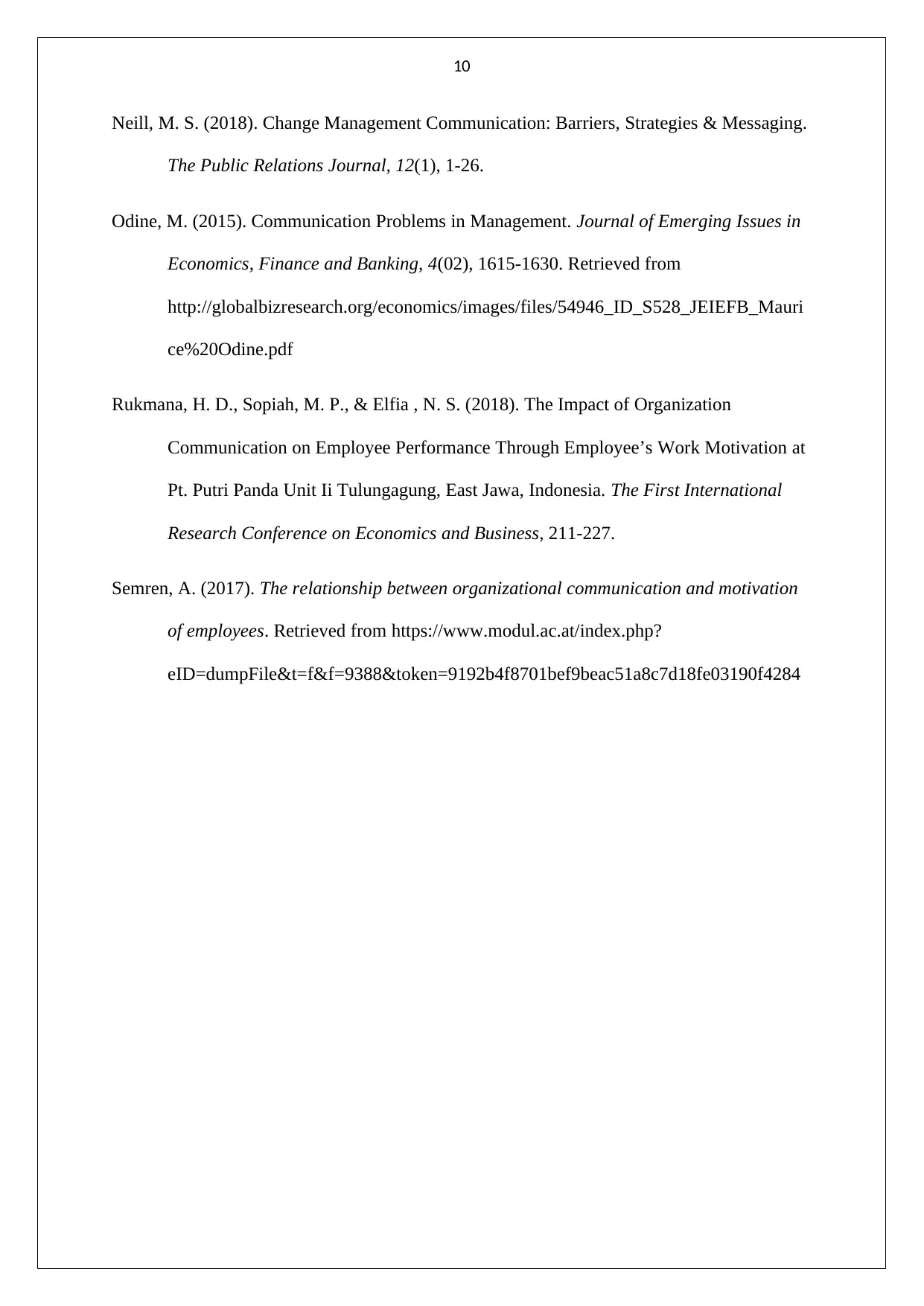
10
Neill, M. S. (2018). Change Management Communication: Barriers, Strategies & Messaging.
The Public Relations Journal, 12(1), 1-26.
Odine, M. (2015). Communication Problems in Management. Journal of Emerging Issues in
Economics, Finance and Banking, 4(02), 1615-1630. Retrieved from
http://globalbizresearch.org/economics/images/files/54946_ID_S528_JEIEFB_Mauri
ce%20Odine.pdf
Rukmana, H. D., Sopiah, M. P., & Elfia , N. S. (2018). The Impact of Organization
Communication on Employee Performance Through Employee’s Work Motivation at
Pt. Putri Panda Unit Ii Tulungagung, East Jawa, Indonesia. The First International
Research Conference on Economics and Business, 211-227.
Semren, A. (2017). The relationship between organizational communication and motivation
of employees. Retrieved from https://www.modul.ac.at/index.php?
eID=dumpFile&t=f&f=9388&token=9192b4f8701bef9beac51a8c7d18fe03190f4284
Neill, M. S. (2018). Change Management Communication: Barriers, Strategies & Messaging.
The Public Relations Journal, 12(1), 1-26.
Odine, M. (2015). Communication Problems in Management. Journal of Emerging Issues in
Economics, Finance and Banking, 4(02), 1615-1630. Retrieved from
http://globalbizresearch.org/economics/images/files/54946_ID_S528_JEIEFB_Mauri
ce%20Odine.pdf
Rukmana, H. D., Sopiah, M. P., & Elfia , N. S. (2018). The Impact of Organization
Communication on Employee Performance Through Employee’s Work Motivation at
Pt. Putri Panda Unit Ii Tulungagung, East Jawa, Indonesia. The First International
Research Conference on Economics and Business, 211-227.
Semren, A. (2017). The relationship between organizational communication and motivation
of employees. Retrieved from https://www.modul.ac.at/index.php?
eID=dumpFile&t=f&f=9388&token=9192b4f8701bef9beac51a8c7d18fe03190f4284
1 out of 11
Related Documents
Your All-in-One AI-Powered Toolkit for Academic Success.
+13062052269
info@desklib.com
Available 24*7 on WhatsApp / Email
![[object Object]](/_next/static/media/star-bottom.7253800d.svg)
Unlock your academic potential
Copyright © 2020–2025 A2Z Services. All Rights Reserved. Developed and managed by ZUCOL.




